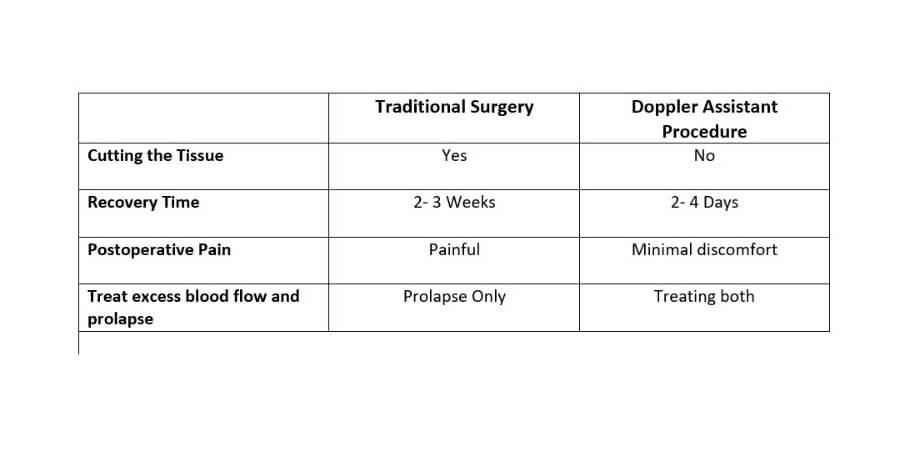King’s doctors are experts in the latest techniques for hemorrhoid treatment. Our minimally invasive and technologically advanced procedures result in minimal pain, quicker recovery, and better patient outcomes compared to traditional approaches. Our advanced hemorrhoids treatments included:
- THD – Assisted Doppler Procedure – Minimally invasive, no excision of tissue, treats excess blood flow and prolapse
- Laser Treatment – Minimally invasive treatment, 15-minute procedure, minimal pain
- The Rafaelo® Procedure – 15-minute procedure. Minimal pain with same-day discharge (Performed by visiting doctor only)
Normally, there are some veins located at the junction of the rectum and the anus, along with the sphincter, these veins and their surrounding tissue are responsible for complete closure of the anus and prevent any leakage. Hemorrhoids, also known as piles, is a very common condition and happens after these veins gets swollen, similar to varicose veins, as a result of bowel movements or due to the increase of abdominal pressure during pregnancy. Everyone has these veins, and problems only arise when they become larger than they should.
Hemorrhoids may be located inside the rectum (internal hemorrhoids), or they may develop under the skin around the anus (external hemorrhoids).
Hemorrhoid Types
- Grade I: Slightly enlarged hemorrhoidal tissue.
- Grade II: Enlarged hemorrhoidal veins protrude with pressing but retract again themselves.
- Grade III: Much larger hemorrhoidal veins which require manual repositioning in the anal canal.
- Grade IV: Extremely large hemorrhoidal veins and tissue with permanent protrusion.
Hemorrhoids Common Causes
The stretching in the lower rectum due to an increase in abdominal pressure is the main cause of hemorrhoids. Other risk factors include:
- Straining during bowel movements or very hard stool
- Pregnancy
- Weakening of the tissue in old age
- Chronic diarrhea or constipation
- Obesity
- An unhealthy lifestyle (lack of exercise, bad eating habits, alcohol, etc.).
- Low fiber diet
Hemorrhoid Symptoms
Hemorrhoids can often be quite painless and may even go virtually unnoticed by the person affected. In some other cases the following symptoms might be presented:
- Bleeding during bowel movements. Usually in the form of bright red blood on the toilet paper.
- Swelling protruding from the anus. In some cases, the hemorrhoids might feel like small lumps in the anus and project from the back passage only after straining on the toilet; in severe cases, the swellings will be constantly visible.
- Pain and discomfort in your anal area.
- Skin irritation and intense itching.
Hemorrhoids symptoms usually depend on the location of the affected veins in the anal canal.
- Internal hemorrhoids, which lie inside the anus and usually are invisible and cause no pain or discomfort. These types of hemorrhoids can get irritated after passing stool and produce the damage of the veins’ surface.
- External hemorrhoids. There are located just under the skin around your anus and gets easily irritated and cause pain or bleeding.
- Thrombosed hemorrhoids. Here, a clot (thrombus) is formed after the blood is pooled in an external hemorrhoid. This type of condition can result in severe pain, swelling and the sensation of a hard lump in the anus. Usually, it requires a minimal surgical procedure to be solved.
What Should I Do If I suffer from Hemorrhoids?
Since this is a very common condition and can cause some very uncomfortable symptoms and discomfort, seeking medical advice is the best option for you. Our doctors will be able to diagnose you and explain the available treatment options.
Hemorrhoid Treatment
Hemorrhoids treatment depends on the severity of symptoms and the size. Grade I hemorrhoids usually can get better by using non-invasive treatments such as creams and dietary changes. Grade II to IV hemorrhoids normally requires a surgical procedure to be solved. However advancements in Hemorrhoid treatments over the past decade now means faster and more effective relief from hemorrhoids is available. Our doctors will be able to discuss the options with you.
Today, King’s offers the latest technology to provide alternative patient-friendly surgical treatment for haemorrhoids that includes an Ultrasound Assistant (US) procedure.
This method is an advanced surgical technique for hemorrhoid treatment, whose main benefit is keeping anorectal anatomy preserved without the removal of hemorrhoids.
During this procedure, the surgeon ligates vessels that bring arterial blood to hemorrhoids, reducing excessive blood flow. This ligation occurs in an area less sensitive to pain and is then followed by the re-positioning of prolapsed hemorrhoids at their original site.

Faqs
الأسئلة الأكثر شيوعا
There are usually two types of haemorrhoids: internal and external.
Haemorrhoids develop when the veins around the lower rectum or anus become inflamed and swollen. Internal haemorrhoids are caused when the veins swell inside the anal canal. However, external haemorrhoids are caused when the veins which are near the opening of the anus swell.
Haemorrhoids can start due to prolonged increased pressure in the rectum vessels. Common activities that can cause this increased pressure are frequent diarrhoea, constipation, sitting for prolonged periods of time, heavy lifting and pregnancy.
Haemorrhoids are common and about half of all individuals will have experienced haemorrhoids by age 50.
Common symptoms of hemorrhoids include bright red blood from the anus, itching around the anus, rectal pain, and thrombosed (protruding) lumps from the anus.
Both internal and external hemorrhoids can have blood clots forming inside the vein (thrombosed) and if blood fills the vein, it can burst. The bleeding usually lasts a few seconds to several minutes (typically less than 10 minutes). However, you should be evaluated by a doctor to ensure that there is no sign of a larger medical issue.
No, hemorrhoids are not known to cause cancer.
If you have hemorrhoids and they do not improve after a week of home care therapy, you should see your physician or a gastroenterologist (digestive health specialist). If your symptoms include rectal pain, itching around the anus, protruding lumps from the anus, or bright red blood from the anus, you should also see a doctor for proper diagnoses as the symptoms may be mimicking other conditions. It is important to rule out other conditions before commencing hemorrhoid treatment.
Your doctor will start by increasing the amount of fibre you are eating so as to make your stool easier to evacuate. Aerobic exercises also help in stimulating bowel function. Over-the-counter creams can initially help with the symptoms but not the cause and they should not be used for more than a week. If initial treatment is not successful, haemorrhoid banding can be considered to remove internal haemorrhoids. Surgery is also an option that can be used but it is rare.
This is a non-surgical technique to remove haemorrhoids. It involves cutting off the blood supply to the haemorrhoid by placing a small rubber band just above the internal haemorrhoid. This causes the haemorrhoid to shrink and the band falls off within 24 hours. The procedure is fast and painless.
BOOK AN APPOINTMENT


